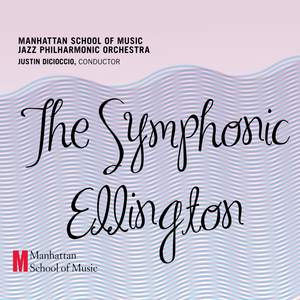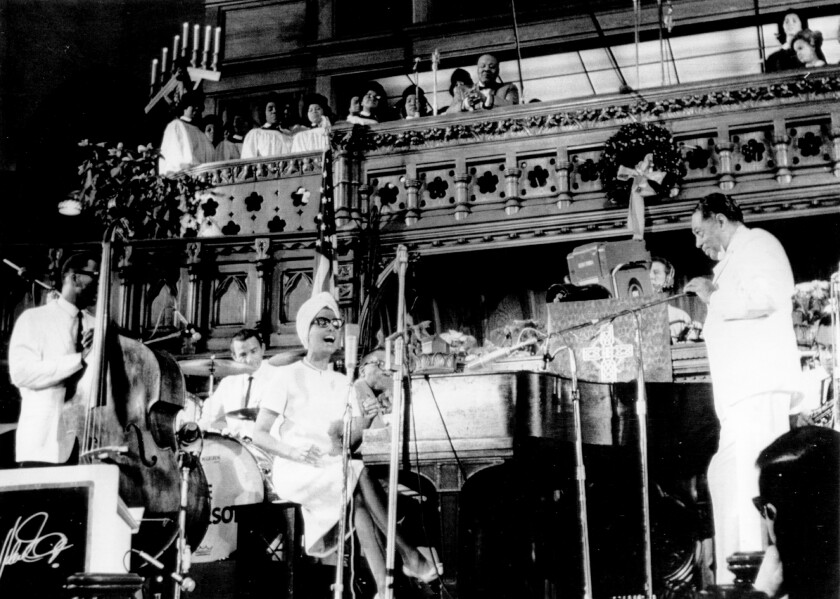Duke Ellington should need no introduction. He did it all. He wrote in the neighborhood of 1,000 songs, many quickly becoming Great American Songbook classics. He transcended musical and racial barriers. He brought jazz music, jazz thinking and jazz attitude to a wide world of music, including the symphony orchestra, ballet, opera, Broadway and the church. He concertized and recorded nonstop for a full five decades.
Nor is Ellington ignored or unappreciated. There is by now a rich and rewarding scholarly literature on Ellington. A statue of the Duke stands in front of Schoenberg Hall on the UCLA campus. The message is unmistakable: Like Arnold Schoenberg, Ellington profoundly and categorically changed the course of 20th century music.
It would obviously be all too easy to believe that Ellington, who was born in 1899, a year after Gershwin and a year before Copland, has easily achieved as central a place in American music and that his influence as all-pervasive as theirs. Ellington is evidently all around us.
The Los Angeles Philharmonic, for instance, recently devoted two programs to the symphonic Ellington. At the same time, Jazz at Lincoln Center, Wynton Marsalis’ big band that follows in Ellington’s footsteps, performed at the Reneé and Henry Segerstrom Concert Hall, while the Harlem Quartet nodded in Ellington’s direction at the Wallis. A couple of days later in Orlando, Fla., the Royal Philharmonic, on tour from London, added an Ellington evening to the celebratory concerts that opened the city’s new Steinmetz Hall.
But Ellington’s legacy — as large and as meaningful as that of any artist in American history — remains enigmatic. We honor him, put him on stamps, name streets and buildings after him and teach him. You can’t begin to talk about American music or issues of race and music and not make Ellington a key part of the conversation. But we still don’t know what to do with Ellington beyond keeping his best-known tunes in rotation.
This was patently clear at the L.A. Phil’s terrific concerts led by Thomas Wilkins, who will also be conducting the L.A. Phil’s YOLA Sunday at So-Fi Stadium on the Super Bowl pregame show. Included were examples of Ellington’s most ambitious works and ones that he said meant the most to him, “Black, Brown and Beige,” “New World A-Comin’” and selections from his “Sacred Concerts.” Yet, these scores, while performed now and then, are not part of the canon.
Jazz-flavored symphonic music is another matter. Gershwin, Ravel, Stravinsky, Milhaud, Copland, Bernstein, Shostakovich, Morton Gould and many more of the classical and semi-classical white greats long ago made jazz a part of their symphonic vocabulary. Orchestras are waking up to the fact that notable Black classical composers — William Grant Still and George Walker in particular, but also others — impressively and importantly did so as well.
That, though, wasn’t Ellington. Rather than incorporate jazz into symphonic realm, he invited the symphonic world into his wondrous realm. He wrote with symphonic intent for his improvising jazz orchestra; he wrote with jazz intent for the standard symphony orchestra; and he happily embraced a hybrid in-between where he and some of his musicians joined forces with the L.A. Phil or many another symphony orchestra.
In all of this, Ellington thought differently, being innovatively pre-symphonic and post-symphonic at the same time. It is not an exaggeration to think of him as a Black Bach. Ellington wrote nonstop for specific performers and performances, as Bach did with, say, his weekly church cantatas. Like Bach, the Duke never repeated himself. He used and reused whatever music he had at hand, brilliantly reimagining his earlier pieces for new purposes. Bach was reputed to have been an improviser of genius at the keyboard. We know for a fact that Ellington was one. We have the recordings, and for some of us our memories.
At another extreme, Ellington created a modern orchestra that has had no equal. It was his instrument. He handpicked the musicians, every one a gifted soloist. Working with many of them for decades, he intimately knew their sound, their personalities and their improvisational skills and styles. Ellington was a collaborative composer, both with his writing partner, Billy Strayhorn, and the musicians in his orchestra.
The challenge of bringing all that pre-symphonic and the improvisational jazz band changeability to a conventional symphony orchestra — in which the exquisitely trained musicians to a far greater (if not complete) degree subsume individuality for the greater good of a glorious collective — has long been deemed incompatible. That is changing, but gradually.
Ellington, consequently, wrote little for the conventional orchestra. He hardly needed to, what with the Duke Ellington Orchestra. But why shouldn’t he have had access to the full resources of a symphony orchestra? Hearing the sheer grandeur of “Black, Brown and Beige” and the splendor of the “Sacred Concerts” played by the L.A. Phil, one of the few orchestras with the versatility to do Ellington justice, added a new magnificence.
Even so, something was lost. “Black, Brown and Beige,” originally a 45-minute suite premiered by Ellington and his orchestra in Carnegie Hall in 1943, is a strikingly direct and deeply probing musical address on race and the experiences of African Americans. It was the first in what he called — with “New World A-Comin’,” “Deep South” Suite, “Liberian” Suite, “Harlem” — chapters in a historical musical epic.
Taken together, these works comprise a momentous symphonic canvas — a challenging, visionary, profound and, yes, pleasure-giving evocation of what it means to be an American in all our pain and promise. Yet this essential American epic has never been performed, recorded or packaged as such. Thanks to the better streaming services, you can, though none too easily, piece it together from various and often obscure recordings, which does little to obviate its shocking neglect.
It is possible to piece together the original “Black, Brown and Beige,” as Marsalis has on an excellent recording with Jazz at Lincoln Center, but the challenges of bringing this work to life are very different than those faced by a symphony orchestra performing a fully notated classical work. Ellington’s music was never a finished product. He was, instead, on the same wavelength as his French conceptual artist contemporary Marcel Duchamp, who said the viewer completes the artwork. For Ellington, the time, place and audience of every performance was different, and so, naturally, must be the music. A “recreated” “Black, Brown and Beige” will always be an anachronism.
Is the symphonic “Black, Brown and Beige” that is commonly trotted out any better? It consists of an unimaginative orchestration of only the “Black” section by Maurice Peress, with some input from Ellington, that practically defies the orchestra to swing. The result falls flat on every recording, Peress’ included. Thanks to Wilkins and several jazz players invited into the orchestral ranks, the saxophone section in particular, it did finally come to life with the L.A. Phil.
But if Ellington is our Bach, then that’s how he needs to be treated. We don’t really know how Bach’s music was performed or how it sounded three centuries ago. So we make it up and always have. The Classical period composers classicized Bach. The Romantics romanticized Bach. The Modernists modernized Bach. The fashion of our time is historically informed performance, or HIP, which, in the end, confronts performers with having to make creative choices. What was thought to be HIP 50 years ago is not HIP now, so radically have research and ideas changed about old music in new contexts.
Our Ellington problem is that we maybe know too much. Recordings readily tempt us to emulate the past. Yet what was HIP for Ellington was to be hip and always change with the time, thus now demanding from us a continual flow of new arrangements, new ways of thinking, new resources and newly trained musicians. If Ellington is to retain his importance to American music, then improvisation needs to be taught as a standard skill for orchestral players.
Ellington did leave behind a handful of relatively standard symphonic scores. Wilkins, who exhibits a musically assured and an Ellingtonian un-demonstrative cool, offered superb performances of “Night Creature” and “The River” Suite, which were written for dance, but even they are suitable for new orchestrations. But it is doubtful that even here Ellington would have wanted them left alone. If Mahler, Ravel, Schoenberg and Leopold Stokowski could orchestrate, or re-orchestrate the great masters, John Adams or Tyshawn Sorey or others should feel welcome to update Ellington.
The hybrid approach, however, continues to work. In 1966, Ellington was the piano soloist with the L.A. Phil at the Hollywood Bowl in his 13-minute piano concerto, “New World A-Comin’.” The orchestra’s noted percussionist and composer, William Kraft, was the sympathetic conductor. In his introduction, Ellington told the large crowd in the amphitheater that “if we can bring about a state of bouncy buoyancy, or swing, we will have made an advancement to a state of no war, no greed, no categorization.” A broadcast recording of the concert, which can be found at mixcloud.com, brings about a state of bouncy buoyancy not found on any commercial recording.

At Disney Hall last week, Gerald Clayton was the soloist. He was not bouncy but supplied buoyancy through a thoughtful fresh intelligence, dazzling virtuosity and an edgy improvisational electricity. He respected Ellington, but, importantly, didn’t speak for Ellington.
Ellington’s three “Sacred Concerts,” his final and most Bachian testament, were created in cathedrals between 1965 and his death nine years later. At Disney, a host of young Black singers well versed in R&B, gospel and other vocal styles brought a necessary now-ness to a sampling of eight numbers from these concerts. In so doing, they held up a mirror to us, our wars, our greed and our continued categorization.
Placed alongside the earlier 1940s concert suites and what Ellington called “tone parallels,” these “Sacred Concerts” complete Ellington’s grand spiritual and social vision of America and race. He never lost his awareness of America’s wrongs; he never lost his optimism and love; he never lost his swing.
I bought a dollar Hollywood Bowl ticket for the 1966 Ellington performance of “New World A-Comin’” and felt like I was witnessing history in the making. Two years later, as a music student at UC Berkeley, I caught the “Second Sacred Concert” at Grace Cathedral in San Francisco but didn’t know what to make of its mix of pirituality and sentimentality, which Ellington insisted was the most important statement he’d ever made.
It took me many years to begin to grapple with the unfathomable complexity of freedom as Ellington studied it, witnessed it and lived it. He asked the questions about race, commercialism and conflict we asked then and we ask again adamantly today.
The L.A. Phil provided an arresting inkling of Ellington’s answers. But for all the scholarship, all the recordings, all the biographies and analyses of his music, all the covers of his tunes, we hardly knew him — and still don’t.








More Stories
This was a gig to match its excellence: Olie Brice at the Vortex: Video, Photos
In tune with Jefferson Berry: A unique blend of acoustic urban storytelling: Videos, Photos
If he were a guitarist he’d be as well-known as Eric Clapton, but Terry Hanck is a sax player! Videos, Photo